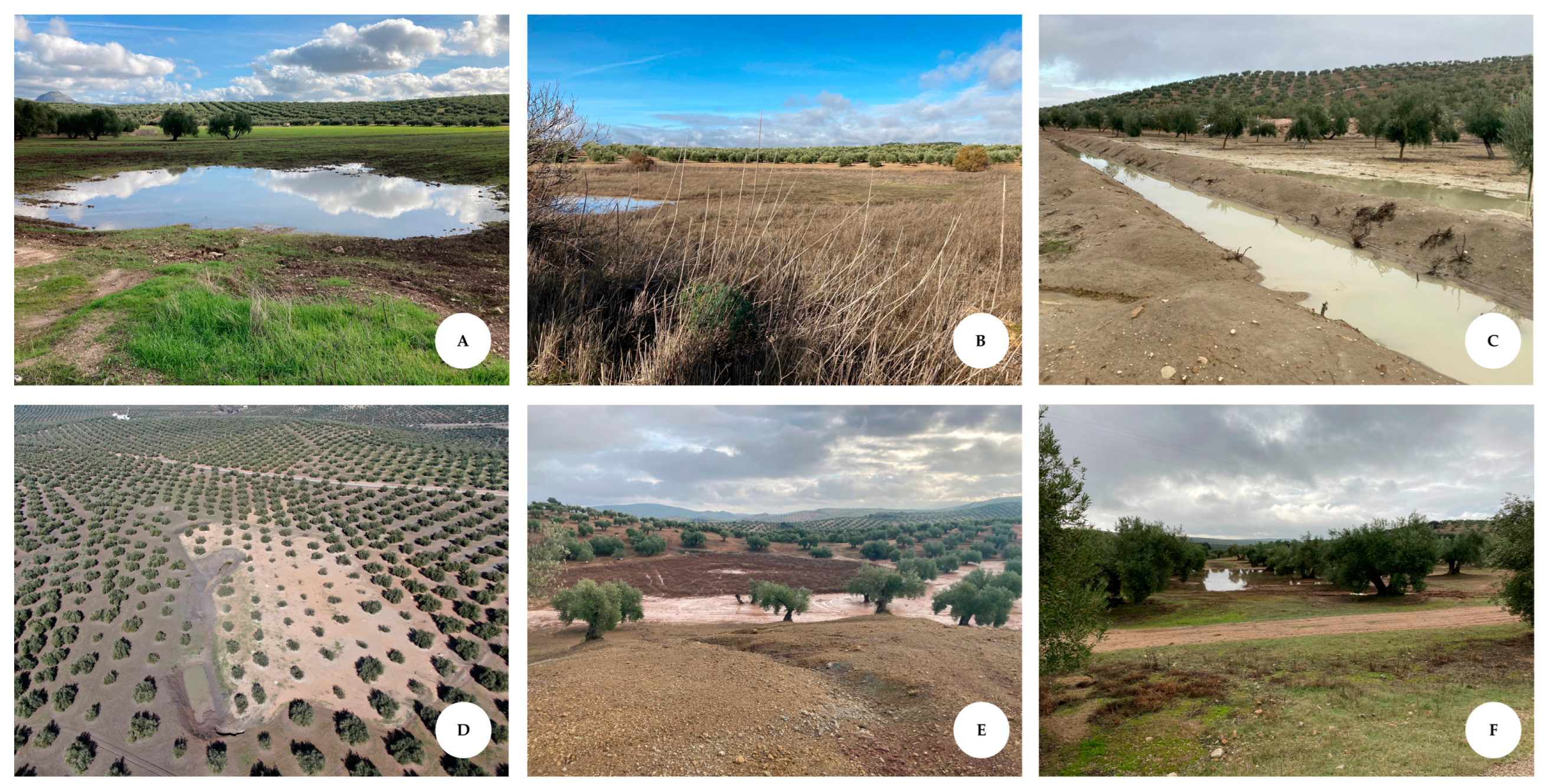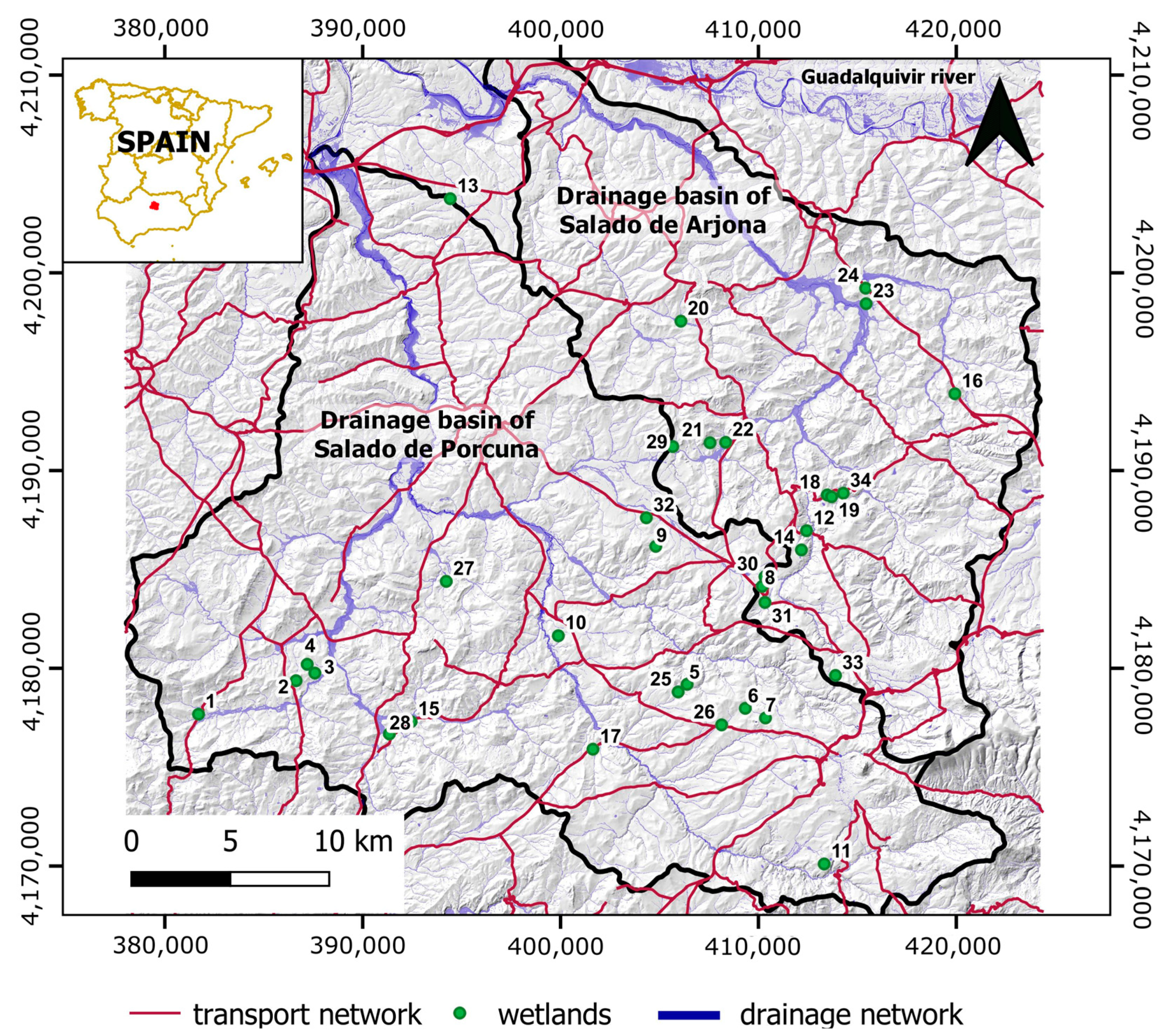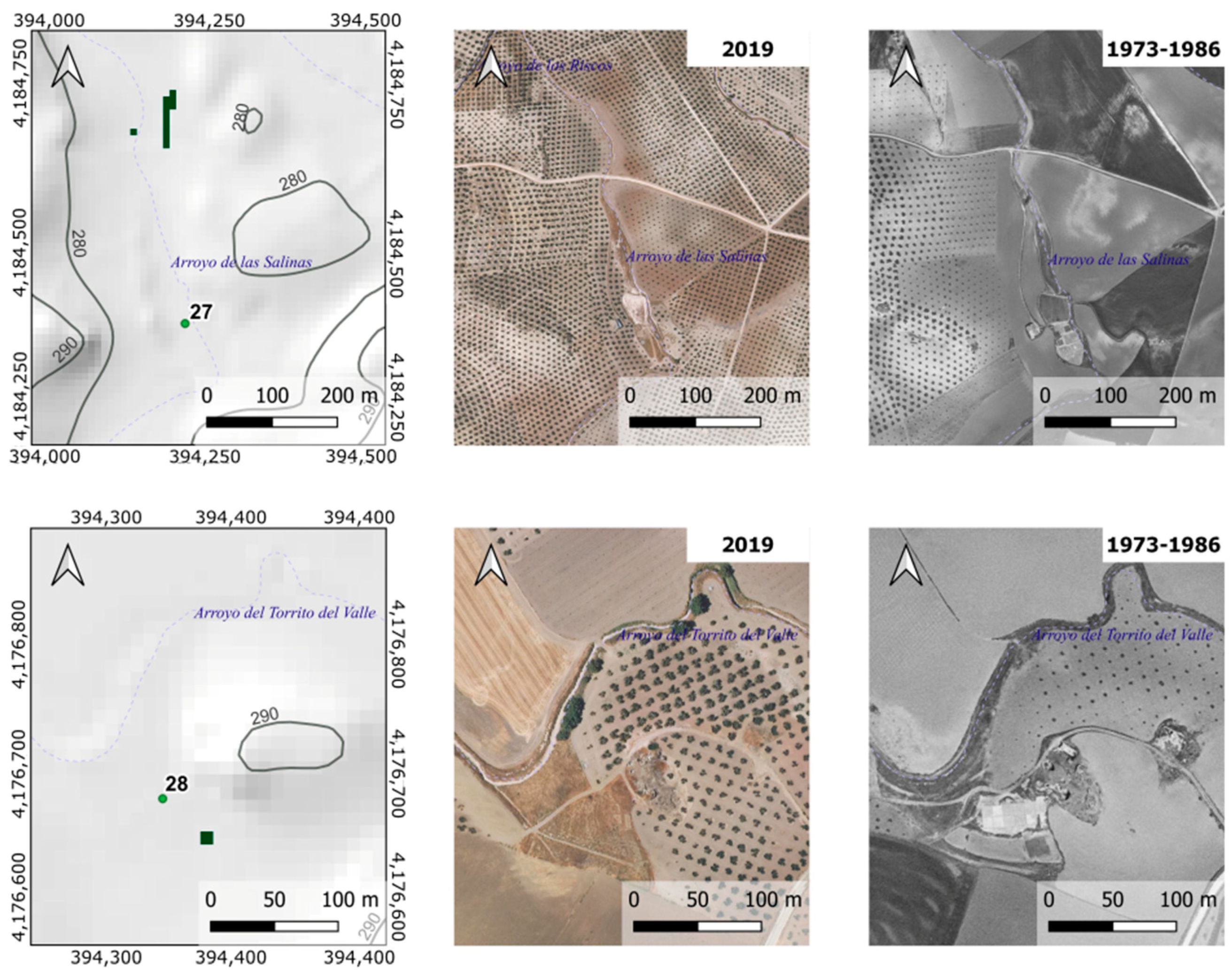Technological Advances to Rescue Temporary and Ephemeral Wetlands: Reducing Their Vulnerability, Making Them Visible
Abstract
1. Introduction
2. Materials and Methods
2.1. Study Site
2.2. Description of Modelling Software
2.3. The Use of IBER+ to Map Temporary and Ephemeral Isolated Wetlands
2.3.1. Configuration of the Physical Parameters in the Hydrological Model
- The maximum rainfall intensity in the previous studied years;
- The duration of a usual rain event in the study area.
2.3.2. Creating a Raster for Wetland Mapping
- The water depth ;
- The magnitude of the water velocity .
2.4. Model Verification
3. Results
4. Discussion
Author Contributions
Funding
Data Availability Statement
Conflicts of Interest
References
- Gudka, M.; Davies, J.; Poulsen, L.; Schulte-Herbrüggen, B.; MacKinnon, K.; Crawhall, N.; Henwood, W.D.; Dudley, N.; Smith, J. Conserving Dryland Biodiversity: A Future Vision of Sustainable Dryland Development. Biodiversity 2014, 15, 143–147. [Google Scholar] [CrossRef]
- Finlayson, C.M.; Capon, S.J.; Rissik, D.; Pittock, J.; Fisk, G.; Davidson, N.C.; Bodmin, K.A.; Papas, P.; Robertson, H.A.; Schallenberg, M.; et al. Policy Considerations for Managing Wetlands Under a Changing Climate. Mar. Freshw. Res. 2017, 68, 1803–1815. [Google Scholar] [CrossRef]
- González Bernáldez, F.; Montes del Olmo, C. Los Humedales del Acuífero de Madrid. Inventario y Tipología Basada en su Origen y Funcionamiento; Departamento de Ecología, Universidad Autónoma de Madrid: Madrid, Spain, 1989. [Google Scholar]
- Casado de Otaola, S.; Montes del Olmo, C. Guía de los Lagos y Humedales de España; Ecosistemas: Madrid, Spain, 1995. [Google Scholar]
- Gilbert, J.D.; de Vicente, I.; Ortega, F.; García-Muñoz, E.; Jiménez-Melero, R.; Parra, G.; Guerrero, F. Linking Watershed Land Uses and Crustacean Assemblages in Mediterranean Wetlands. Hydrobiologia 2017, 799, 181–191. [Google Scholar] [CrossRef]
- Jiménez-Melero, R.; Jarma, D.; Gilbert, J.D.; Ramírez-Pardo, J.M.; Guerrero, F. Cryptic Diversity in a Saline Mediterranean Pond: The Role of Salinity and Temperature in the Emergence of Zooplankton Egg Banks. Hydrobiologia 2023, 850, 3013–3029. [Google Scholar] [CrossRef]
- Let, M.; Pal, S. Socio-Ecological Well-being Perspectives of Wetland Loss Scenario: A Review. J. Environ. Manag. 2023, 326, 116692. [Google Scholar] [CrossRef]
- Barbosa, L.G.; Amorim, C.A.; Parra, G.; Laco Portinho, J.; Morais, M.; Morales, E.A.; Menezes, R.F. Advances in Limnological Research in Earth’s Drylands. Inland Waters 2020, 10, 429–437. [Google Scholar] [CrossRef]
- Fluet-Chouinard, E.; Stocker, B.D.; Zhang, Z.; Malhotra, A.; Melton, J.R.; Poulter, B.; Kaplan, J.O.; Goldewijk, K.K.; Siebert, S.; Minayeva, T.; et al. Extensive Global Wetland Loss Over the Past Three Centuries. Nature 2023, 614, 281–286. [Google Scholar] [CrossRef]
- Darrah, S.E.; Shennan-Farpón, Y.; Loh, J.; Davidson, N.C.; Finlayson, C.M.; Gardner, R.C.; Walpole, M.J. Improvements to the Wetland Extent Trends (WET) Index as a Tool for Monitoring Natural and Human-made Wetlands. Ecol. Ind. 2019, 99, 294–298. [Google Scholar] [CrossRef]
- Borja Barrera, C.; Camacho González, A.; Florín Beltrán, M. Lagos y Humedales en la Evaluación de los Ecosistemas del Milenio en España. Ambient. Rev. Minist. Medio Ambiente 2012, 98, 82–90. [Google Scholar]
- Finlayson, C.; Everard, M.; Irvine, K.; McInnes, R.J.; Middleton, B.A.; van Dam, A.; Davidson, N. The Wetland Book I: Structure and Function, Management and Methods; Springer: Berlin, Germany, 2018. [Google Scholar]
- WFD. WFD Directive 2000/60/EC of the European Parliament and of the Council of 23 October 2000 Establishing a Framework for Community Action in the Field of Water Policy; European Parliament: Strasbourg, France, 2000.
- Beklioglu, M.; Romo, S.; Kagalou, I.; Quintana, X.; Bécares, E. State of the Art in the Functioning of Shallow Mediterranean Lakes: Workshop Conclusions. Hydrobiologia 2007, 584, 317–326. [Google Scholar] [CrossRef]
- Zacharias, I.; Zamparas, M. Mediterranean Temporary Ponds. A Disappearing Ecosystem. Biodivers. Conserv. 2010, 19, 3827–3834. [Google Scholar] [CrossRef]
- Jeppesen, E.; Brucet, S.; Naselli-Flores, L.; Papastergiadou, E.; Stefanidis, K.; Nõges, T.; Nõges, P.; Attayde, J.L.; Zohary, T.; Coppens, J.; et al. Ecological Impacts of Global Warming and Water Abstraction on Lakes and Reservoirs Due to Changes in Water Level and Related Changes in Salinity. Hydrobiologia 2015, 750, 201–227. [Google Scholar] [CrossRef]
- EC. Horizon Europe—Work Programme 2023–2024 Food, Bioeconomy, Natural Resources, Agriculture and Environment; European Commission: Brussels, Belgium, 2022.
- Calhoun, A.J.; Mushet, D.M.; Bell, K.P.; Boix, D.; Fitzsimons, J.A.; Isselin-Nondedeu, F. Temporary Wetlands: Challenges and Solutions to Conserving a ‘disappearing’ ecosystem. Biol. Conserv. 2017, 211, 3–11. [Google Scholar] [CrossRef]
- Rover, J.R.; Mushet, D.M. Mapping Wetlands and Surface Water in the Prairie Pothole Region of North America: Chapter 16. In Remote Sensing of Wetlands: Applications and Advances; CRC Press: Boca Raton, FL, USA, 2015. [Google Scholar]
- Palmeri, L.; Trepel, M. A GIS-Based Score System for Siting and Sizing of Created or Restored Wetlands: Two Case Studies. Water Resour. Manag. 2002, 16, 307–328. [Google Scholar] [CrossRef]
- Bartsch, A.; Wagner, W.; Scipal, K.; Pathe, C.; Sabel, D.; Wolski, P. Global Monitoring of Wetlands—The Value of ENVISAT ASAR Global Mode. J. Environ. Manag. 2009, 90, 2226–2233. [Google Scholar] [CrossRef]
- Liu, Y.; Zhang, H.; Zhang, M.; Cui, Z.; Lei, K.; Zhang, J.; Yang, T.; Ji, P. Vietnam Wetland Cover Map: Using Hydro-Periods Sentinel-2 Images and Google Earth Engine to Explore the Mapping Method of Tropical Wetland. Int. J. Appl. Earth Obs. 2022, 115, 103122. [Google Scholar] [CrossRef]
- Sanz Ramos, M.; Cea Gómez, L.; Bladé i Castellet, E.; Lopez Gomez, D.; Sañudo Costoya, E.; Corestein Poupeau, G.; García Alén, G.; Aragón Hernández, J.L. Iber V3: Manual de Referencia E Interfaz de Usuario de las Nuevas Implementaciones; International Centre for Numerical Methods in Engineering: Barcelona, Spain, 2022. [Google Scholar]
- Bladé, E.; Cea, L.; Corestein, G.; Escolano, E.; Puertas, J.; Vázquez-Cendón, E.; Dolz, J.; Coll, A. Iber: Herramienta De Simulación Numérica Del Flujo En Ríos. Rev. Int. Métodos Numéricos Cálculo Diseño Ing. 2014, 30, 1–10. [Google Scholar] [CrossRef]
- García-Feal, O.; González-Cao, J.; Gómez-Gesteira, M.; Cea, L.; Domínguez, J.M.; Formella, A. An Accelerated Tool for Flood Modelling Based on Iber. Water 2018, 10, 1459. [Google Scholar] [CrossRef]
- Morales-Hernández, M.; Sharif, M.B.; Kalyanapu, A.; Ghafoor, S.K.; Dullo, T.; Gangrade, S.; Kao, S.; Norman, M.R.; Evans, K.J. TRITON: A Multi-GPU Open Source 2D Hydrodynamic Flood Model. Environ. Model. Softw. 2021, 141, 105034. [Google Scholar] [CrossRef]
- Caviedes-Voullième, D.; Morales-Hernández, M.; Norman, M.R.; Özgen-Xian, I. SERGHEI (SERGHEI-SWE) V1.0: A Performance-Portable High-Performance Parallel-Computing Shallow-Water Solver for Hydrology and Environmental Hydraulics. Geosci. Model Dev. 2023, 16, 977–1008. [Google Scholar] [CrossRef]
- Sharifian, M.K.; Kesserwani, G.; Chowdhury, A.A.; Neal, J.; Bates, P. LISFLOOD-FP 8.1: New GPU-Accelerated Solvers for Faster Fluvial/Pluvial Flood Simulations. Geosci. Model Dev. 2023, 16, 2391–2413. [Google Scholar] [CrossRef]
- IGN. Spanish National Geographic Institute. Plan Nacional de Ortofotografía Aérea. Available online: http://pnoa.ign.es/ (accessed on 30 January 2022).
- Peral-García, P.; Fernández-Victorio, B.; Ramos-Calzado, P. Serie de Precipitación Diaria en Rejilla con Fines Climáticos.; Agencia Estatal de Meteorología, Ministerio para la Transición Ecológica y el Reto Demográfico: Madrid, Spain, 2017.
- Bohorquez, P.; Del Moral-Erencia, J.D. 100 Years of Competition between Reduction in Channel Capacity and Streamflow during Floods in the Guadalquivir River (Southern Spain). Remote Sens. 2017, 9, 727. [Google Scholar] [CrossRef]
- del Moral-Erencia, J.D.; Bohorquez, P.; Jimenez-Ruiz, P.J.; Pérez-Latorre, F.J. Flood Hazard Mapping with Distributed Hydrological Simulations and Remote-Sensed Slackwater Sediments in Ungauged Basins. Water 2021, 13, 3434. [Google Scholar] [CrossRef]
- REDIAM. WMS Mapa de Suelos de Andalucía; REDIAM: Seville, Spain, 2023. [Google Scholar]
- Durán, J.J.; López-Martınez, J. Torcal De Antequera, Karst Yesıfero De Gobantes, Sierras De Abdalajıs Y Desfiladeros De El Chorro. Elementos de los Paisajes de la Provincia de Málaga; Servicio de Publicaciones de la Universidad de Málaga: Málaga, Spain, 1999; pp. 111–130. [Google Scholar]
- Junta de Andalucía. Plan Andaluz De Humedales; Junta de Andalucía: Andalucía, Spain, 2002.
- Ortega, F.; Parra, G.; Guerrero, F. Los humedales del Alto Guadalquivir: Inventario, tipologías y estado de conservación. In Ecología, Manejo y Conservación de los Humedales; Paracuellos, M., Ed.; Instituto de Estudios Almerienses: Almería, Spain, 2003; pp. 113–123. [Google Scholar]
- Pérez-Montiel, J.I.; Cardenas-Mercado, L.; Nardini, A.G.C. Flood Modeling in a Coastal Town in Northern Colombia: Comparing MODCEL Vs. IBER. Water 2022, 14, 3866. [Google Scholar] [CrossRef]
- Boughton, W.C. A Review of the USDA SCS Curve Number Method. Soil Res. 1989, 27, 511–523. [Google Scholar] [CrossRef]
- Mishra, S.K.; Jain, M.K.; Bhunya, P.K.; Singh, V.P. Field Applicability of the SCS-CN-Based Mishra–Singh General Model and its Variants. Water Resour. Manag. 2005, 19, 37–62. [Google Scholar] [CrossRef]
- van Asselen, S.; Verburg, P.H.; Vermaat, J.E.; Janse, J.H. Drivers of Wetland Conversion: A Global Meta-Analysis. PLoS ONE 2013, 8, e81292. [Google Scholar] [CrossRef]
- Williams, P.; Biggs, J.; Fox, G.; Nicolet, P.; Whitfield, M. History, Origins and Importance of Temporary Ponds. Freshw. Forum 2001, 17, 7–15. [Google Scholar]
- Huang, J.; Yu, H.; Guan, X.; Wang, G.; Guo, R. Accelerated Dryland Expansion Under Climate Change. Nat. Clim. Chang. 2016, 6, 166–171. [Google Scholar] [CrossRef]
- Boix, D.; Biggs, J.; Céréghino, R.; Hull, A.P.; Kalettka, T.; Oertli, B. Pond Research and Management in Europe: “Small is Beautiful”. Hydrobiologia 2012, 689, 1–9. [Google Scholar] [CrossRef]
- Boix, D.; Kneitel, J.; Robson, B.J.; Duchet, C.; Zúñiga, L.; Day, J.; Gascón, S.; Sala, J.; Quintana, X.D.; Blaustein, L. Invertebrates of freshwater temporary ponds in Mediterranean climates. In Invertebrates in Freshwater Wetlands; Springer: Berlin/Heidelberg, Germany, 2016; pp. 141–189. [Google Scholar]
- Gooden, J.; Pritzlaff, R. Dryland Watershed Restoration with Rock Detention Structures: A Nature-Based Solution to Mitigate Drought, Erosion, Flooding, and Atmospheric Carbon. Front. Environ. Sci. 2021, 9, 679189. [Google Scholar] [CrossRef]
- Bohorquez, P.; Pérez-Latorre, F.J.; González-Planet, I.; Jiménez-Melero, R.; Parra, G. Nature-Based Solutions for Flood Mitigation and Soil Conservation in a Steep-Slope Olive-Orchard Catchment (Arquillos, SE Spain). Appl. Sci. 2023, 13, 2882. [Google Scholar] [CrossRef]
- Dottori, F.; Mentaschi, L.; Bianchi, A.; Alfieri, L.; Feyen, L. Cost-Effective Adaptation Strategies to Rising River Flood Risk in Europe. Nat. Clim. Chang. 2023, 13, 196–202. [Google Scholar] [CrossRef]
- Parra, G.; Guerrero, F.; Armengol, J.; Brendonck, L.; Brucet, S.; Finlayson, C.M.; Gomes-Barbosa, L.; Grillas, P.; Jeppesen, E.; Ortega, F. The Future of Temporary Wetlands in Drylands Under Global Change. Inland Waters 2021, 11, 445–456. [Google Scholar] [CrossRef]
- Rodríguez Aguilera, A. Las salinas del señorío de la Orden Militar de Calatrava en Andalucía: Estudio histórico y arqueológico. In Las Órdenes Militares en la Península Ibérica; Izquierdo Benito, R., Ruiz Gómez, F., Eds.; Ediciones de la Universidad de Castilla-La Mancha: Ciudad Real, Spain, 2000; pp. 173–192. [Google Scholar]
- Fornell Muñoz, A.; Martínez, J.M.C. Aproximación al estudio de las salinas de Jaén en época romano. In Economía de los Humedales: Prácticas Sostenibles y Aprovechamientos Históricos.; Lagóstena, L.G., Ed.; Edicions de la Universitat de Barcelona: Barcelona, Spain, 2019; pp. 89–108. [Google Scholar]
- Iranzo-García, E.; Kortekaas, K.H.; López, E.R. Inland Salinas in Spain: Classification, Characterisation, and Reflections on Unique Cultural Landscapes and Geoheritage. Geoheritage 2021, 13, 24. [Google Scholar] [CrossRef]
- Blumenfeld, S.; Lu, C.; Christophersen, T.; Coates, D. Water, Wetlands and Forests. A Review of Ecological, Economic and Policy Linkages; Secretariat of the Convention on Biological Diversity: Montreal, Canada; Secretariat of the Ramsar Convention on Wetlands: Gland, Switzerland, 2009; pp. 1–38. [Google Scholar]
- Convention on Wetlands. Global Wetland Outlook: Special Edition Gland; Secretariat of the Convention on Wetlands: Gland, Switzerland, 2021. [Google Scholar]
- Díaz, S.M.; Settele, J.; Brondízio, E.; Ngo, H.; Guèze, M.; Agard, J.; Arneth, A.; Balvanera, P.; Brauman, K.; Butchart, S. The Global Assessment Report on Biodiversity and Ecosystem Services: Summary for Policy Makers; IPBES Secretariat: Bonn, Germany, 2019. [Google Scholar]
- Millennium Ecosystem Assessment. Ecosystems and Human Well-Being: Wetlands and Water; World Resources Institute: Washington, DC, USA, 2005. [Google Scholar]
- UNESCO World Water Assessment Programme. The United Nations World Water Development Report 2020: Water and Climate Change; UNESCO: Paris, France, 2020; p. 219. [Google Scholar]






| Parameter | |
|---|---|
| Rainfall intensity (P) | 5.4 mm·h−1 |
| Rainfall duration | 24 h |
| Manning roughness (n) | 0.025 s·m−1/3 |
| ) | 0 |
| Computational mesh | 20 × 106 square cells with a uniform size of 10 m |
| ) | 0.1 m |
| ) | 0.025 m·s−1 |
| Wetland | Name | Type | Longitude | Latitude | Area (ha) [Source] | Inventory | Raster Detection |
|---|---|---|---|---|---|---|---|
| 1 | de La Roa | 2 | 4°20′33.480″O | 37°44′19.039″N | 1.76 [a] | [35] | FN |
| 2 | La Quinta | 1 | 4°17′13.287″O | 37°45′16.221″N | 7.70 [a] | [35,36] | TP |
| 3 | Rincón del Muerto | 1 | 4°16′34.275″O | 37°45′29.243″N | 4.64 [a] | [35,36] | TP |
| 4 | Casasola | 1 | 4°16′50.321″O | 37°45′43.475″N | 1.94 [a] | [35,36] | TP |
| 5 | Hituelo 1 | 1 | 4°3′46.699″O | 37°45′18.285″N | 5.43 [a] | [35,36] | TP |
| 6 | Naranjeros | 1 | 4°01’44.814″O | 37°44′40.279″N | 5.04 [c] | [35,36] | TP |
| 7 | Rumpisaco | 1 | 4°1′03.908″O | 37°44′24.342″N | 1.37 [c] | [35,36] | TP |
| 8 | Casillas I | 1 | 4°1′13.290″O | 37°48′0.703″N | 2.55 [a] | [35,36] | TP |
| 9 | Las Navas 1 | 1 | 4°4′53.954″O | 37°49′5.583″N | 3.45 [a] | [35,36] | TP |
| 10 | Los Amores | 1 | 4°08′11.773″O | 37°46′35.051″N | 4.72 [c] | - | TP |
| 11 | Mollica | 2 | 3°58′58.570″O | 37°40′26.508″N | 0.33 [c] | - | TP |
| 12 | el Yeso | 4 | 3°59′41.471″O | 37°49′33.769″N | 0.49 [c] | - | FP |
| 13 | de las Viñas | 2 | 4°12′07.600″O | 37°58′30.750″N | 0.40 [c] | - | TP |
| 14 | de la Rata | 3 | 3°59′52.477″O | 37°49′01.290″N | 0.77 [c] | - | TP |
| 15 | del Cordel de Jaén | 4 | 4°13′14.124″O | 37°44′11.900″N | 2.61 [c] | - | FP |
| 16 | Colmenero | 1 | 3°54′38.592″O | 37°53′20.267″N 1 | 5.57 [c] | [36] | TP |
| 17 | Las Ceras | 1 | 4°06′58.200″O | 37°43′30.778″N 1 | 1.17 [c] | [36] | TP |
| 18 | Villardonpardo 2 | 3 | 3°59′00.900″O | 37°50′31.909″N 1 | 1.63 [c] | [36] | TP |
| 19 | Villardonpardo 3 | 2 | 3°58′51.269″O | 37°50′29.274″N 1 | 0.26 [c] | [36] | TP |
| 20 | El Ranal | 3 | 4°12′05.479″O | 37°55′14.236″N 1 | 9.80 [c] | [36] | TP |
| 21 | del Obispo | 3 | 4°03′04.495″O | 37°51′56.758″N 1 | 0.50 [b] | [36] | TP |
| 22 | Los Prados | 3 | 4°02′29.216″O | 37°51′55.397″N 1 | 33.60 [c] | [36] | TP |
| 23 | San José | 3 | 3°57′27.705″O | 37°55′58.530″N 1 | 11.90 [b] | [36] | TP |
| 24 | Corbún | 4 | 3°57′45.166″O | 37°56′12.084″N 1 | 2.75 [c] | [36] | FP |
| 25 | Hituelo 2 | 3 | 4°04′06.184″O | 37°45′06.527″N 1 | 3.30 [b] | [36] | FN |
| 26 | Mojones | 1 | 4°02′32.896″O | 37°44′13.265″N 1 | 4.63 [c] | [36] | TP |
| 27 | Salinas de La Orden | 2 | 4°12′05.479″O | 37°48′02.678″N 1 | 0.59 [c] | [36] | TP |
| 28 | Salinas de Valdeutiel | 1 | 4°13′59.453″O | 37°43′51.514″N 1 | 1.30 [b] | [36] | TP |
| 29 | Torrealcazar | 3 | 4°04′27.723″O | 37°51′57.856″N 2 | 1.44 [c] | [36] | TN |
| 30 | Casillas 2 | 1 | 3°54′38.592″O | 37°53′20.267″N 1 | 2.11 [c] | [36] | TP |
| 31 | Casillas 3 | 2 | 4°01′06.412″O | 37°47′35.290″N 1 | 2.03 [c] | [36] | TP |
| 32 | Las Navas 2 | 4 | 4°04′43.270″O | 37°49′49.850″N 1 | 0,50 [b] | [36] | FP |
| 33 | El Hornillo | 2 | 3°58′38.114″O | 37°45′36.842″N 1 | 1,20 [c] | [36] | TP |
| 34 | Villardonpardo 1 | 1 | 3°58′27.526″O | 37°50′35.203″N 1 | 2,18 [c] | [36] | TP |
Disclaimer/Publisher’s Note: The statements, opinions and data contained in all publications are solely those of the individual author(s) and contributor(s) and not of MDPI and/or the editor(s). MDPI and/or the editor(s) disclaim responsibility for any injury to people or property resulting from any ideas, methods, instructions or products referred to in the content. |
© 2023 by the authors. Licensee MDPI, Basel, Switzerland. This article is an open access article distributed under the terms and conditions of the Creative Commons Attribution (CC BY) license (https://creativecommons.org/licenses/by/4.0/).
Share and Cite
Jiménez-Melero, R.; Bohorquez, P.; González-Planet, I.; Pérez-Latorre, F.J.; Parra, G. Technological Advances to Rescue Temporary and Ephemeral Wetlands: Reducing Their Vulnerability, Making Them Visible. Remote Sens. 2023, 15, 3553. https://doi.org/10.3390/rs15143553
Jiménez-Melero R, Bohorquez P, González-Planet I, Pérez-Latorre FJ, Parra G. Technological Advances to Rescue Temporary and Ephemeral Wetlands: Reducing Their Vulnerability, Making Them Visible. Remote Sensing. 2023; 15(14):3553. https://doi.org/10.3390/rs15143553
Chicago/Turabian StyleJiménez-Melero, Raquel, Patricio Bohorquez, Inmaculada González-Planet, Francisco José Pérez-Latorre, and Gema Parra. 2023. "Technological Advances to Rescue Temporary and Ephemeral Wetlands: Reducing Their Vulnerability, Making Them Visible" Remote Sensing 15, no. 14: 3553. https://doi.org/10.3390/rs15143553
APA StyleJiménez-Melero, R., Bohorquez, P., González-Planet, I., Pérez-Latorre, F. J., & Parra, G. (2023). Technological Advances to Rescue Temporary and Ephemeral Wetlands: Reducing Their Vulnerability, Making Them Visible. Remote Sensing, 15(14), 3553. https://doi.org/10.3390/rs15143553








